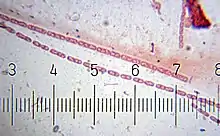| Streptobacillus | |
|---|---|
 | |
| Streptobacillus Numbered ticks are 11 µm apart | |
| Scientific classification | |
| Domain: | Bacteria |
| Phylum: | Fusobacteriota |
| Class: | Fusobacteriia |
| Order: | Fusobacteriales |
| Family: | Leptotrichiaceae |
| Genus: | Streptobacillus Levaditi, Nicolau & Poincloux 1925 |
| Type species | |
| Streptobacillus moniliformis Levaditi, Nicolau & Poincloux 1925 | |
| Species[1] | |
| |
| Synonyms | |
| |
Streptobacillus is a genus of fastidious microaerophilic Gram-negative bacteria, which grow in culture as rods in chains.[2]
Species associated with infection - S. moniliformis
Reported susceptibilities and therapies - penicillin, erythromycin
Diseases
Associated infections: the Haverhill fever form of rat bite fever. (Notes Spirillum minus is also an agent of rat bite fever, in the form known as Sodoku.)
Haverhill fever, which is characterized by fever, rash, chills, headache, vomiting, muscle pain, arthritis, and bacteremia, and by weight loss and diarrhea in children.
Commentary
Rat bite fever is caused by either Streptobacillus moniliformis or Spirillum minor. The incidence of rat-bite fever is highest in urban areas with poor sanitation where the rat population is high, however in recent times cases have also been attributed to occupational contact with rodents such as pet shop employees or laboratory workers or through pet ownership.[3]
While the disease is usually caused by a bite, it can also occur from close contact with rodents or ingestion of contaminated food or water. The latter is known as Haverhill fever. The disease typically presents with chills and fever accompanied by headache, vomiting, and muscle pain. A rash and arthritis develop 2–4 days after the initial onset. Less commonly the infection can cause pneumonitis, endocarditis or meningitis. As these symptoms are common to many febrile diseases, this is often classified as a fever of unknown origin (FUO). If untreated, death will occur in approximately 10% of cases.[4]
Phylogeny
The currently accepted taxonomy is based on the List of Prokaryotic names with Standing in Nomenclature (LPSN)[5] and National Center for Biotechnology Information (NCBI)[1]
| 16S rRNA based LTP_08_2023[6][7][8] | 120 marker proteins based GTDB 08-RS214[9][10][11] | |||||||||||||||||||||||||||||||||||||||||||||||||||||||||||||||||||||
|---|---|---|---|---|---|---|---|---|---|---|---|---|---|---|---|---|---|---|---|---|---|---|---|---|---|---|---|---|---|---|---|---|---|---|---|---|---|---|---|---|---|---|---|---|---|---|---|---|---|---|---|---|---|---|---|---|---|---|---|---|---|---|---|---|---|---|---|---|---|---|
|
|
See also
References
- 1 2 Sayers; et al. "Streptobacillus". National Center for Biotechnology Information (NCBI) taxonomy database. Retrieved 2022-09-09.
- ↑ Procop, Gary W. (2017). Koneman's color atlas and textbook of diagnostic microbiology. Church, Deirdre L., 1955-, Hall, Geraldine S.,, Janda, William M., 1951-, Koneman, Elmer W., 1932-, Schreckenberger, Paul,, Woods, Gail L. (Seventh ed.). Philadelphia. ISBN 978-1-4511-1659-5. OCLC 876002916.
{{cite book}}: CS1 maint: location missing publisher (link) - ↑ Papanicolas, Lito E; Holds, Judith M; Bak, Narin (20 February 2012). "Lessons from practice - Meningitis and pneumonitis caused by pet rodents". The Medical Journal of Australia. 196 (3): 202–203. doi:10.5694/mja11.10841. PMID 22339528.
- ↑ Elliott, S. P. (11 January 2007). "Rat Bite Fever and Streptobacillus moniliformis". Clinical Microbiology Reviews. 20 (1): 13–22. doi:10.1128/CMR.00016-06. PMC 1797630. PMID 17223620.
- ↑ J.P. Euzéby. "Streptobacillus". List of Prokaryotic names with Standing in Nomenclature (LPSN). Retrieved 2022-09-09.
- ↑ "The LTP". Retrieved 20 November 2023.
- ↑ "LTP_all tree in newick format". Retrieved 20 November 2023.
- ↑ "LTP_08_2023 Release Notes" (PDF). Retrieved 20 November 2023.
- ↑ "GTDB release 08-RS214". Genome Taxonomy Database. Retrieved 10 May 2023.
- ↑ "bac120_r214.sp_label". Genome Taxonomy Database. Retrieved 10 May 2023.
- ↑ "Taxon History". Genome Taxonomy Database. Retrieved 10 May 2023.
- Szewc, Adam M, BellI, Melissa E (2021). "Using the BDFX40 Automated Continuous Blood Culture System to Isolate and Recover Streptobacillus moniliformis in the Presence of 0.05% SPS: A 55-Year, 56-Strain Retrospective Study". Laboratory Medicine. 52 (6): 536–49. doi:10.1093/labmed/lmab009. PMID 33693831.
External links
- A Web-Surfer's Guide to Bacteria Associated with Infections in Humans
- Streptobacillus moniliformis
- Streptobacillus at the U.S. National Library of Medicine Medical Subject Headings (MeSH)